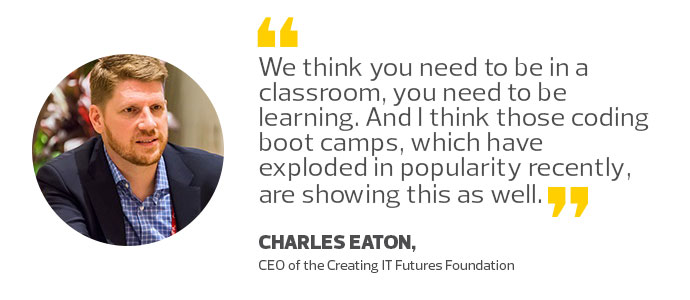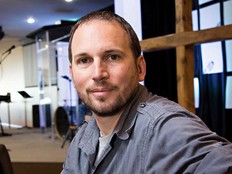Q&A: Charles Eaton Uses IT Career Training to Give People a Path to Prosperity
The call for IT talent is getting louder, but the number of people answering the call isn’t matching the higher volume.
According to the 2015 Gartner report “Service Providers Are Waging War Against U.S. Talent Shortage With Unconventional Methods,” the issue is coming to a head in the very near future.
By 2020, there will be 1.4 million computer specialist job openings, according to the U.S. Department of Labor. But projections show universities are not likely to produce enough qualified graduates to fill even about 30% of these jobs.
Those sobering statistics mean more talent must enter the IT field from unconventional sources, because even if more people in higher education shift to IT education, that alone won’t cover the gap.
That’s where the Creating IT Futures Foundation steps in. As the nonprofit arm of the venerable and widely renowned IT certification association CompTIA, the foundation has an innate understanding of what it takes to train and prepare people to work in IT. The foundation is giving this training and education to at-risk and underserved populations, and also working with groups that have historically been underrepresented in IT, such as women and ethnic minorities.
We spoke with Charles Eaton, CEO of the Creating IT Futures Foundation, to understand why he believes the foundation’s actions are impactful, and how his nonprofit is leveraging technology to fuel its operations and accomplish his mission.
The foundation also runs a blog, which BizTech named one of its Must-Read Nonprofit IT Blogs this year.
BIZTECH: What is the mission and purpose of the Creating IT Futures Foundation?
EATON: We’re the philanthropic arm of CompTIA. So if someone donates to us, it’s tax deductible. We work hand in hand with CompTIA and many of our staff are located in the CompTIA offices in Downers Grove, Ill.
Creating IT Futures is focused on the talent pipeline problem in IT. We look at the issues that employers have and ask why aren’t they able to hire qualified individuals? What can we do for those people who never had the opportunity and aren’t in a position to go back to school? What can we do to get them back to work? What can we do to get people just entering high school and college to get them interested in IT as a career?
BIZTECH: What is your organization’s approach to training and educating the next generation of IT talent?
EATON: There’s a lot of talk about MOOCs [Massive Open Online Courses] and other forms of online training. Unfortunately, the data shows that for a lot of people who lack strong educational background, those online training methods don’t work very well. You can coach someone’s behavior better when they’re face to face.
We were doing online training hoping people would take them and find jobs, but we moved to a much more hands-on approach. We think you need to be in a classroom, you need to be learning. And I think those coding boot camps, which have exploded in popularity recently, are showing this as well.
You need to build students’ confidence up, put them around people in the same situation that they are in. Once you’ve done that, then you can give them access to online learning for continuing education.
And the results of this approach are proven with our results: 88 percent of students are still working in IT two years after leaving us. We really look at, How do you create that amazing experience while you have them for a short period of time, 8 weeks, and give them tools with online training to support them after that?

BIZTECH: What technology does your organization rely on for this training and education?
EATON: In our facility in Minneapolis, we have desktops set up. It is all PC-based. The PCs are ours, we own them, but we reimage them every time and all of our curriculum and labs are PC-based.
We also do pop-up programs, which we do in the city. We bring in laptops for that and our instructors bring in whiteboards and projectors. That part doesn’t have to be real high tech.
So much of the education and training is about teaching people the soft skills, the behaviors. The reality is you end up learning constantly in technology. What we teach, there’s going to be 100 things they’re going to experience that first week in the job that we might not have covered in depth. It’s about priming these individuals to work in these environments.
BIZTECH: So that covers the in-person, on-site education and training. What technology do you use for the continuing education after they leave your program?
EATON: CompTIA has a very nice test-prep tool called CERTMaster. It’s a test-prep tool that uses really interesting ways of verifying that you know the information. Before you get to that, we give you an online version of a book. How could we make that better? What else is going to be out there in terms of the pedagogy to get them to learn? Flash cards on mobile devices are available, and I thought they were fantastic for my certification. It’s very self-directed. Unfortunately, grants for our program typically don’t cover alumni issues. So we have to raise money if we want to expand upon what we have.
BIZTECH: How is crowdfunding impacting fundraising for Creating IT Futures?
EATON: A lot of crowdfunding connects on an emotional level. Pets, loved ones with diseases, for example. Individual giving tends to be low for workforce nonprofits, however. People tend to look at it as “How come that person is getting a free ride?” People put a lot of baggage on someone who’s out of work. So we find that companies and governments tend to provide a lot of the funding for our organization.
In Minnesota, now that we have success and 250 alumni, we’re going to look for a platform that will allow an individual to raise funds and attach it to an event that will start in the fall. But we’ve got to tell those stories in a meaningful way so people understand the value of giving.
BIZTECH: What technology is most essential to your organization as a nonprofit?
EATON: Really it’s SaaS. I don’t like any piece of software that we have to install, outside of what CompTIA has that we use as a necessity. Our team uses cloud-based services like Box and Smartsheet. We use WorkFlowy to do brainstorming and a lot of our project management happens in Smartsheet.
We’ve been able to drive CompTIA to use Smartsheet, which is great, but we also use Skype for Business.
BIZTECH: How has the mobile revolution impacted your organization’s operations and its mission?
EATON: I don’t want any software that doesn’t have an app. And even then it should be a native app. I’d prefer to have that.
We’re not in the same kind of position that many companies are, in that there are sales processes that we have to follow. Just keeping track of your calendar and email is essential. What’s interesting now for us is that we’re going to be designing a more sophisticated application for devices, and we’ll be working with a software development firm making sure these are best-in-class experiences.
The bar is raised on mobile in that the expectations of consumers are so high. They expect that it’s going to work well and you have to keep up. So that requires more of an investment in software development.
You need to be able to keep up with what consumers are expecting. They’re not going to go, “Oh, you’re a nonprofit so it’s ok that your website sucks.” At the same time, it can’t be all flash.
BIZTECH: Looking toward the future, are there any other technologies you’d like to bring into your nonprofit?
EATON: Soon we’re going to have to have a virtual reality application. [laughs] When VR gets commercialized, I’d love to have videos of the people in our class who are learning because it can change minds. I think for nonprofits, VR will be enormous. Especially for global development ones. VR will be a game-changer for sure.









